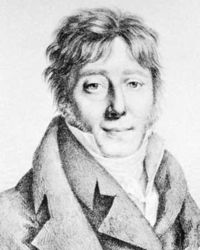Annotation:Napoleon's Coronation March: Difference between revisions
No edit summary |
No edit summary |
||
| Line 1: | Line 1: | ||
== | __NOABC__ | ||
<div class="noprint"> | |||
<p><font face="Century Gothic" size="4"> Back to [[{{BASEPAGENAME}}]] </font></p> | |||
</div> | |||
---- | ---- | ||
<p><font face=" | {{#lst:{{PAGENAME}}|abc}} | ||
---- | |||
<div style="page-break-before:always"></div> | |||
<p><font face="Century Gothic" size="2"> | |||
<div style="text-align: justify; direction: ltr; margin-bottom: 90px; margin-left: 70px; margin-right: 120px;"> | |||
<br> | |||
'''NAPOLEON'S CORONATION MARCH.''' G Major. Standard tuning (fiddle). One part. Jean-François LeSueur [http://en.wikipedia.org/wiki/Jean-Fran%C3%A7ois_Le_Sueur] (1760-1837), "Performed for the first time on Sunday, 2 December, 1804." Composer LeSueur was the music director at Napoleon and Josephine's coronation ceremony and composed several marches and motets for the event. The royal couple mounted the steps to the entrance to Notre-Dame where they were sprinkled them with holy water, then entered the church to the sound of LeSueur's coronation march. He boasted in 1837 that the music performed at the coronation was an oratorio he had written, but there is no evidence that he ever produced such a work. His "Marche du sacre" (Coronation March) was to be re-used for the coronation of Charles X. | '''NAPOLEON'S CORONATION MARCH.''' G Major. Standard tuning (fiddle). One part. Jean-François LeSueur [http://en.wikipedia.org/wiki/Jean-Fran%C3%A7ois_Le_Sueur] (1760-1837), "Performed for the first time on Sunday, 2 December, 1804." Composer LeSueur was the music director at Napoleon and Josephine's coronation ceremony and composed several marches and motets for the event. The royal couple mounted the steps to the entrance to Notre-Dame where they were sprinkled them with holy water, then entered the church to the sound of LeSueur's coronation march. He boasted in 1837 that the music performed at the coronation was an oratorio he had written, but there is no evidence that he ever produced such a work. His "Marche du sacre" (Coronation March) was to be re-used for the coronation of Charles X. | ||
<br> | <br> | ||
<br> | <br> | ||
[[File:Lesueur.jpg|200px|thumb|left|Jean-François LeSueur]] | [[File:Lesueur.jpg|200px|thumb|left|Jean-François LeSueur]] | ||
LeSueur was a native of Abbeville, and the son of poor peasants and a self-taught musician and composer. He had a penchant for martial music, and was a favorite of Napoleon's (who, after the debut of his opera '''The Bards''', received a gold snuff-box inscribed, "From the Emperor to the author of 'The Bards'"--inside were 6,000 francs in notes). He was one of the founders of the Conservatoire of Music in Paris. He died in Paris at an advanced age, universally respected and admired. | LeSueur was a native of Abbeville, and the son of poor peasants and a self-taught musician and composer. He had a penchant for martial music, and was a favorite of Napoleon's (who, after the debut of his opera '''The Bards''', received a gold snuff-box inscribed, "From the Emperor to the author of 'The Bards'"--inside were 6,000 francs in notes). He was one of the founders of the Conservatoire of Music in Paris. He died in Paris at an advanced age, universally respected and admired. | ||
<br> | |||
<br> | <br> | ||
The march was entered (as "Buonapart's Coronation March") in the c. 1850 music manuscript collection of Lake District musician William Irwin. | |||
<br> | <br> | ||
</div> | |||
</font></p> | </font></p> | ||
<p><font face=" | <div class="noprint"> | ||
''Source for notated version'': | <p><font face="Century Gothic" size="2"> '''Additional notes''' </font></p> | ||
<p><font face="Century Gothic" size="2"> | |||
<font color=red>''Source for notated version''</font>: - | |||
<br> | <br> | ||
<br> | <br> | ||
</font></p> | </font></p> | ||
<p><font face=" | <p><font face="Century Gothic" size="2"> | ||
''Printed sources'': Laybourn ('''Köhler's Violin Repository, Book One'''), 1881; p. 49. | <font color=red>''Printed sources''</font> : - Laybourn ('''Köhler's Violin Repository, Book One'''), 1881; p. 49. | ||
<br> | <br> | ||
<br> | <br> | ||
</font></p> | </font></p> | ||
<p><font face=" | <p><font face="Century Gothic" size="2"> | ||
''Recorded sources'': <font color=teal></font> | <font color=red>''Recorded sources'': </font> <font color=teal> - </font> | ||
</font></p> | </font></p> | ||
<br> | <br> | ||
---- | ---- | ||
== | <p><font face="Century Gothic" size="4"> Back to [[{{BASEPAGENAME}}]] </font></p> | ||
</div> | |||
__NOEDITSECTION__ | |||
__NOTITLE__ | |||
Revision as of 17:45, 19 February 2019
X:41 T:Buonapart's Coronation March. WI.041 M:C| L:1/8 Q:1/4=100 B:Wm Irwin, Folio MS, c1850. AGG's Transcription R:.Air O:England A:Lake District Z:vmp.Chris Partington.2005 K:D f4 g4|a2a>a a2g>f|g2g>g g2a>b|[f3a3][eg] [f2d2] A>d| f2-f3g/f/ ed|{f}g2g3{b}a/g/ f2e2|"etc....A.G.G."zzzz|]
NAPOLEON'S CORONATION MARCH. G Major. Standard tuning (fiddle). One part. Jean-François LeSueur [1] (1760-1837), "Performed for the first time on Sunday, 2 December, 1804." Composer LeSueur was the music director at Napoleon and Josephine's coronation ceremony and composed several marches and motets for the event. The royal couple mounted the steps to the entrance to Notre-Dame where they were sprinkled them with holy water, then entered the church to the sound of LeSueur's coronation march. He boasted in 1837 that the music performed at the coronation was an oratorio he had written, but there is no evidence that he ever produced such a work. His "Marche du sacre" (Coronation March) was to be re-used for the coronation of Charles X.

LeSueur was a native of Abbeville, and the son of poor peasants and a self-taught musician and composer. He had a penchant for martial music, and was a favorite of Napoleon's (who, after the debut of his opera The Bards, received a gold snuff-box inscribed, "From the Emperor to the author of 'The Bards'"--inside were 6,000 francs in notes). He was one of the founders of the Conservatoire of Music in Paris. He died in Paris at an advanced age, universally respected and admired.
The march was entered (as "Buonapart's Coronation March") in the c. 1850 music manuscript collection of Lake District musician William Irwin.
